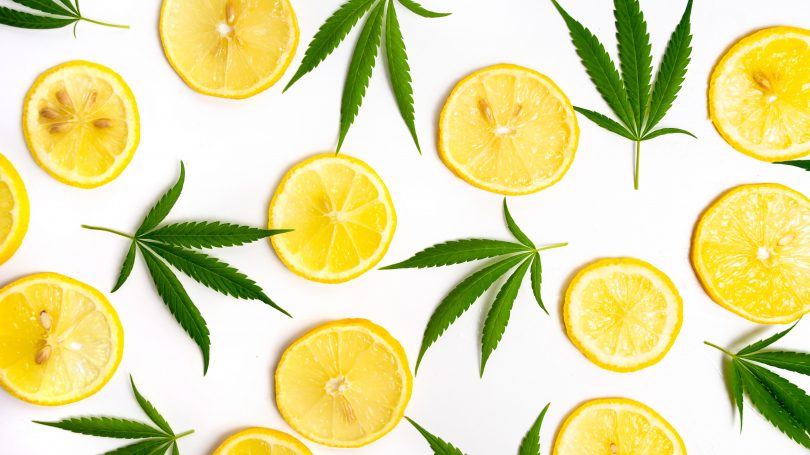Terpenes are a diverse group of organic compounds produced by plants, fruits, and vegetables. Terpenes are used by some plants to deter animals, but many also have significant therapeutic and medicinal value for humans.
It’s a well-known fact that humans, animals, and plants have evolved in tandem throughout the ages, at least on some level. For example, some terpenes inside plants are known to benefit humans and to bring them closer to a state of homeostasis or “perfect equilibrium.” These terpenes affect various intricate systems inside the human body, and if they go out of whack or aren’t regulated correctly, it can lead to illness and various other ailments.
The body is continually attempting to bring itself to a state of homeostasis. It does this via three central systems: The Endocrine System, The Neuroendocrine System, and the Endocannabinoid System. Let’s start by taking a look at these systems and the roles they play in regulating health, sleep, mood, appetite, and a range of other things.
After that, we’ll take a closer look at how and why terpenes work for people suffering from a range of conditions. We’ll also look at some of the most popular terpenes, and how they’re used to promote healthfulness and wellbeing.
Interested in smokable hemp flowers?
The BEST CBD flowers are only available to the readers of the CBD Flowers Weekly newsletter.
Subscribe below.
The Endocrine System
One of the intricate systems inside the body that controls mood, sleep, sexual function, growth, and other things is the endocrine system. The system is made up of glands, which secrete hormones throughout the body. The endocrine system includes the thyroid, pituitary gland, testicles, ovaries, adrenal glands, pancreas, and parathyroid glands.
These glands work together to balance the body, and the more balanced they are, the better. The glands absorb matter from the bloodstream and then release back only the substances that are required to bring the body to homeostasis.
The Neuroendocrine System
Another finely-tuned system that regulates the body is the neuroendocrine system. This system is closely related to the endocrine system and includes many of the same glands.
However, the neuroendocrine system also contains various non-endocrine tissues, hormones, neurons, and neurochemicals. Certain cells, abundant in the neuroendocrine system, produce specific hormones in response to a myriad of neurological signals and stimuli.
The Endocannabinoid System
The endocannabinoid system, known as the ECS, present inside the body, also regulates a variety of daily functions. As the name suggests, this system is the symbiosis of various cannabinoids from cannabis and hemp plants, interacting uniquely with the body. The ECS consists of receptors located in the organs of the body called CB1 and CB2 receptors.
CBD, for example, doesn’t infiltrate these receptors but does encourage them to work in a balanced and optimal way. The ECS is partially responsible for regulating appetite, mood, and sleep. It’s also interesting as it supports the case that some scientists make that humans and plant life have evolved together in unique ways over millennia. Terpenes also affect the ECS in a variety of different ways.
Working Together
These intricate systems work uniquely to regulate certain daily functions for humans. That includes getting the right amount of (good quality) sleep, eating at the right time of day and generally feeling upbeat and content.
The body will do its utmost to keep itself balanced and in check to reach homeostasis. Homeostasis includes things like blood sugar levels, breathing, and body temperature. Interestingly, some terpenes are known to balance the systems we discussed in humans.
Terpenes and Humans
The main organs in the body responsible for bringing people to a state of equilibrium are the brain, liver, and kidneys. The brain controls balance within the hypothalamus or the endocrine system. At the same time, the liver controls how the body metabolizes carbohydrates. The kidneys are responsible for several bodily functions, including blood water levels, salt levels, and balanced pH levels.
Terpenes are a secondary metabolite produced by plants like cannabis. What that means is that those secondary metabolites – such as terpenes – play no role whatsoever in the growth or reproduction of the plant. That means the terpenes could have no other purpose other than to benefit humans and animals (or deter them.) Terpenes are produced by trees like conifer and fir, and also by fruits. As such, terpenes have been used in alternative medicine for centuries to treat conditions like pain, inflammation, depression, anxiety, and insomnia, among other conditions that affect humans.
Terpenes are also in citrus fruits and vegetables and have been used for years in essential oils, particularly by the aromatherapy community. Most beauty, skincare, and hair products contain some form of terpenes, and that even includes your kitchen floor cleaner. When terpenes are infused into a room, not only do they make the area smell nice, they also make people feel better. Terpenes bind to receptors in the systems and encourage the body to reach homeostasis.
Terpene Varieties
We know that around 200 different terpenes exist and that some are more predominant than others depending on where they grow. While the precise mechanism of how terpenes affect humans is still shrouded in mystery, we do know that they target receptors and neurotransmitters in the brain.
Moreover, terpenes are considered to be one of the main things that bring the body into balance, and without them, one can feel under the weather. Many experts understand that terpenes help people with mental disorders and depression. Nevertheless, there are different varieties of terpenes, and they are used in various ways to target a range of issues.
While some terpenes offer a boost of energy, others lower stress. Terpenes are also thought to strengthen the immune system and are often used by cancer patients recovering from chemotherapy. The most popular and well-known terpenes are Myrcene, Pinene, Linalool, and Limonene, but that’s just to name a few.
The clue is in the name here, as pinene is a terpene that grows in pine trees, while lemons are abundant with Limonene. However, it’s the terpenes from cannabis which interest many people, and there are some logical reasons for that.
Ways to Take Terpenes
Assisting the body to reach homeostasis is a great thing to do. Taking the right terpenes in the right way is an excellent way of working towards that goal. Terpenes are already widely used in alternative medicine as well as by the pharmaceutical industry. There are two primary ways to take terpenes: naturally and via aromatherapy, with a third way being the introduction of cannabis terpenes, in one form or another.
Ever heard of “forest bathing?” It’s a real thing, and that’s why many people feel invigorated and relaxed after a long stroll in the woods, especially if there are conifers, firs, and pine trees around. Simply by passively breathing in during a long walk in a forest, terpenes are taken into the body via the lungs and attach to various receptors.
The aromatherapy method is a little more scientific and, according to most, a lot more effective. Particular essential oils are used by some people, for example, to treat Seasonal Affective Disorder (SAD). Oils that are terpene enriched are known to boost serotonin levels and lead to feelings of peace and tranquility.
Terpenes in high concentrations are taken by many in cannabis or CBD flowers. When either of these is smoked or vaporized, a large amount of the terpenes specific to that cannabis or hemp strain will enter the system via the lungs. Terpenes are also added to broad and full spectrum cannabis and CBD oil tinctures or to edibles such as gummy bears or cupcakes. Despite the controversy, CBD products are a great way to take terpenes and to encourage the body to a state of homeostasis.
Spotlight on Terpenes
Terpenes all have unique aromas and are easily distinguishable to the discerning eye. Some terpenes are lemony or smell like berries. Others are musky and piney and more reminiscent of the forest. Here’s a quick-reference list of some of the best-known terpenes and what they’re used for.
- Myrcene – Most common terpene. Prevalent in indicia varieties of cannabis and used as an analgesic, an anti-inflammatory, and as an antibiotic.
- Pinene – Second most common terpene and the most prevalent in cannabis plants. Pinene is so-called as it also grows in fir, conifer and pine trees. This terpene is used for its anti-inflammatory properties and as a local antiseptic.
- Linalool – Another prevalent terpene, Linalool has a floral, often spicy aroma. Working as an anti-inflammatory, this terpene also aids neutral function and kills bacteria and some strains of fungi.
- Limonene – This terpene gets its name from its lemony, citrusy smell. Considered to be a more uplifting and invigorating terpene, Limonene is often found in cannabis Sativa varieties. Limonene is also used as an anti-bacterial, anti-inflammatory, and to treat anxiety.
- Camphene – Camphene is a lesser-known terpene but one that is very useful for some conditions. With a delicate, herbal aroma, this terpene is used as an antibiotic and, like most of the others, is also anti-inflammatory.
- Caryophyllene – This terpene is identifiable from its hop-like aroma. It’s also present in hops, a close relative of cannabis and hemp. Caryophyllene is used to treat depression, anxiety, and panic attacks.
One of the most effective ways to take terpenes is by using CBD oil or vape liquid. Let’s take a look at how terpenes are used inside these products and how they benefit a variety of people with different medical issues.
Using CBD Oil For Terpenes
According to Dr. Leah Zachar, a specialist in the field of CBD, terpenes are “volatile and pharmacologically active molecules, which not only enhance the ability of CBD to exert its benefits but also have their own benefits.” However, there are different types of CBD oil, and not all are equal. CBD Isolate contains no terpenes at all and is just 100% CBD.
Full Spectrum CBD Oil contains a natural balance of CBD and terpenes which are retained and preserved during the extraction process. Full Spectrum CBD Oil is the best option if you’re looking to get the full benefits from the terpenes, regardless of whether the CBD is secondary to you or not. Broad Spectrum CBD Oil is similar to Full Spectrum oil but contains only tiny trace amounts of THC. To benefit from the so-called “Entourage Effect,” Full Spectrum oil is the way to go.
Terpenes For Health & Wellbeing
Terpenes can be easily incorporated into your daily health regime or lifestyle. One of the best ways to do this is by using Full or Broad Spectrum CBD oil. Bear in mind that CBD and terpenes are non-addictive, non-toxic, and non-psychoactive. Many people who use them regularly report feelings of calm and wellbeing. Other people use terpenes and CBD more vigorously to treat things like anxiety, pain, and sleeplessness.
Ingesting CBD oil isn’t the only way to take terpenes into the system. CBD edibles are another convenient and effective way to take terpenes, but with ingestion, it takes up to two hours for the full and rounded effects to be felt. Some premium CBD vape juices (or CBD E-liquids as they’re also known) are packed with terpenes. In some cases, you can even choose which specific terpenes you want if you find the right vendors. When CBD and terpenes are taken via the lungs when vaping or indeed smoking (CBD or THC flowers), the effects are felt almost immediately and are long-lasting and potent.
Whichever method you ultimately decide is best for you, always do your homework to ensure you’re purchasing your terpenes from reputable vendors only. A rule of thumb for this is to check for third-party lab results which any dependable CBD vendor will provide transparently and openly. Online reviews from verified buyers are also a good idea to familiarize yourself with the most popular and most current products.
For more stories like this one, subscribe to the Medical Cannabis Weekly Newsletter.







